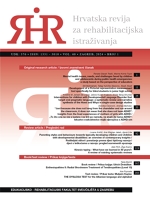„To što ona ne visi s lustera i ne trči po razredu, ne znači da nema ADHD“: Iskustvo svakodnevice majki djevojčica s ADHD-om
“Just because she does not hang from the chandelier and run around the classroom, it does not mean that she does not have ADHD”: Insights from the lived experiences of mothers of girls with ADHD
Author(s): Dorotea Čevizović, Andreja BartolacSubject(s): Individual Psychology, Cognitive Psychology, Developmental Psychology, Clinical psychology, Behaviorism
Published by: Sveučilište u Zagrebu, Edukacijsko-rehabilitacijski fakultet
Keywords: ADHD; neurodiversity; girls; support; qualitative design; life experience;
Summary/Abstract: Attention deficit/hyperactivity disorder (ADHD) is a neurodevelopmental condition characterised by difficulties in cognitive, emotional, and behavioural self-regulation. Boys are more frequently diagnosed with ADHD than girls. Due to the lack of research on the specific symptomatology that occurs in girls with ADHD and their everyday experiences, a semi-structured interview was conducted with six mothers of girls with ADHD. The thematic analysis of the transcript generated five main themes: 1. “Invisible” girls with ADHD, symptomatology, and late diagnosis: “The fact that she does not hang from the chandelier and does not run around the class does not mean that she does not have ADHD”; 2. Organisation of everyday family life: “One day is too short for us, time flies too quickly”; 3. Experience of schooling a girl with ADHD: “The whole family dynamic revolves around school”; 4. Attitudes of society, professionals, and systems: “Unfortunately, there is no support for girls with ADHD”; 5. Personal experiences of motherhood: “I sense how much I wore myself out in certain situations of that life path of ours”. The results of our analysis indicate that girls are diagnosed with ADHD much later, even though characteristics symptoms are present and significantly affect their everyday life. Similar to boys with ADHD, the symptoms observed in girls are most pronounced in school-related activities and daily occupations that involve executive functions. There is a lack of systematic and socialsupport for girls with ADHD and their mothers. The mothers who participated in the interviews emphasised the need for more sensitivity and understanding among professionals and the society regarding the fact that ADHD does not occur only in boys and that it is not defined only by hyperactivity.
Journal: Hrvatska revija za rehabilitacijska istraživanja
- Issue Year: 60/2024
- Issue No: 1
- Page Range: 53-91
- Page Count: 39
- Language: English, Croatian

